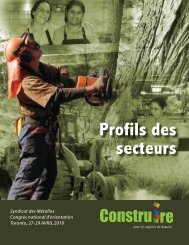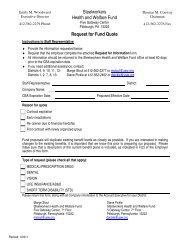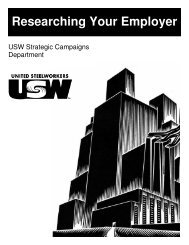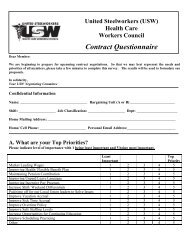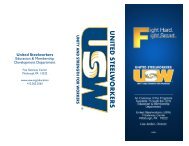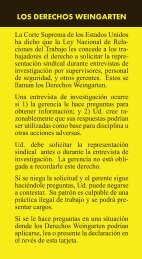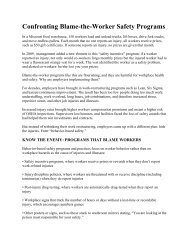Union Approach to Health and Safety: - United Steelworkers
Union Approach to Health and Safety: - United Steelworkers
Union Approach to Health and Safety: - United Steelworkers
Create successful ePaper yourself
Turn your PDF publications into a flip-book with our unique Google optimized e-Paper software.
workers are blamed for workplace injuries, accident prevention focuses on the least<br />
effective methods of hazard control. Workers are blamed for not wearing personal<br />
protective equipment or for not following safety procedures.<br />
Behavior-based safety programs undermine health <strong>and</strong> safety by excusing management’s<br />
past <strong>and</strong> current shortcomings. These programs focus attention on workers, who in most<br />
cases had little or nothing <strong>to</strong> do with the selection of machinery, equipment, work<br />
processes, work organization, materials or methods of safeguarding.<br />
When workers believe they will be blamed for an accident or injury, <strong>and</strong> may face some<br />
type of inquisition or discipline, accidents <strong>and</strong> injuries go unreported. Problems that go<br />
unreported will not get addressed, <strong>and</strong> will certainly result in future injuries <strong>and</strong> even<br />
tragedies.<br />
Regarding “accident-proneness,” every one of us is “Accident-Prone Andy” at various<br />
times in our lives. We are distracted by family issues <strong>and</strong> relationship problems. We may<br />
not have gotten a good night’s sleep. We may be having medical problems. Or sometimes<br />
we just have a bad day. All these conditions are absolutely normal. Safe design of<br />
machinery, equipment, work processes <strong>and</strong> work organization assumes that workers will<br />
have occasional bad days <strong>and</strong> will make mistakes. When a workplace is designed <strong>and</strong><br />
maintained safely, workers do not need <strong>to</strong> be blamed, fixed or fired. It is the workplace<br />
that gets fixed, not the workers.<br />
Questions To Ask When An Injury, Incident, Accident Or Near-Miss Occurs<br />
To get <strong>to</strong> the root cause of a problem, <strong>and</strong> get past efforts <strong>to</strong> pin the blame on “worker<br />
carelessness” or “accident-proneness,” make sure that questions get asked about why a<br />
worker did or did not do a certain thing.<br />
“But Why?”<br />
An effective method for getting <strong>to</strong> the root cause of injuries, incidents <strong>and</strong> accidents in<br />
the workplace is <strong>to</strong> ask the question “but why?” as follows:<br />
Carol got something in her eye at work.<br />
But why?<br />
Because a metal chip went flying through the air <strong>and</strong> l<strong>and</strong>ed in her eye.<br />
But why?<br />
Because there was no enclosure around the machine <strong>to</strong> contain the metal chips.<br />
But why?<br />
Because the company didn’t want <strong>to</strong> spend the money on this kind on this kind of<br />
engineering control.<br />
But why?<br />
Because the company knows it costs less <strong>to</strong> have workers wear PPE than <strong>to</strong> fix<br />
the problem machine by enclosing it.




